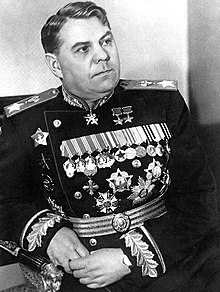Our website is made possible by displaying online advertisements to our visitors.
Please consider supporting us by disabling your ad blocker.
Aleksandr Vasilevsky
Aleksandr Vasilevsky | |
|---|---|
Александр Василевский | |
 Vasilevsky in 1944 | |
| Minister of War | |
| In office 25 February 1950 – 15 March 1953 | |
| Premier | Joseph Stalin (1950–1953) Georgy Malenkov (1953) |
| Preceded by | Position established |
| Succeeded by | Position abolished (Post re-established as Ministry of Defence, with Nikolai Bulganin succeeding) |
| Minister of the Armed Forces | |
| In office 24 March 1949 – 25 February 1950 | |
| Premier | Joseph Stalin |
| Preceded by | Nikolai Bulganin |
| Succeeded by | Position abolished |
| Personal details | |
| Born | 30 September 1895 Novaya Golchikha, Vichuga, Russian Empire |
| Died | 5 December 1977 (aged 82) Moscow, Russian SFSR, Soviet Union |
| Resting place | Kremlin Wall Necropolis, Moscow |
| Awards | Hero of the Soviet Union (2) Order of Victory (2) Order of Suvorov, 1st Class Order of Lenin (8) Order of the Red Banner (2) Virtuti Militari |
| Military service | |
| Allegiance | (1915–1917) (1917–1922) (1922–1959) |
| Years of service | 1915–1959 |
| Rank | Marshal of the Soviet Union |
| Commands | Chief of the General Staff 3rd Belorussian Front Far East Command |
| Battles/wars | |
Aleksandr Mikhaylovich Vasilevsky (Russian: Александр Михайлович Василевский; 30 September 1895 – 5 December 1977) was a Soviet general who served as a top commander during World War II and achieved the rank of Marshal of the Soviet Union. During World War II, he served as the chief of the General Staff and deputy Minister of Defense, and later served as Minister of Defense from 1949 to 1953.
Born in central Russia, Vasilevsky began his military career in the Imperial Russian Army during World War I and earned the rank of captain by 1917. After the October Revolution of 1917 and the start of the Russian Civil War, he was conscripted into the Red Army and took part in the Polish-Soviet War. Following the war, Vasilevsky quickly rose through the ranks, and in 1931 was appointed to the Directorate of Military Training. In 1939, after Joseph Stalin's Great Purge, he was appointed deputy chief of operations of the Red Army.
Soon after the German invasion of the Soviet Union in June 1941, Vasilevsky was promoted to chief of operations and deputy chief of the general staff on the recommendation of his mentor Boris Shaposhnikov. In June 1942, he succeeded Shaposhnikov as chief of the general staff, and also became deputy minister of defense that October. In these capacities, Vasilevsky coordinated fronts and often planned offensives in collaboration with Georgy Zhukov, particularly at the Battle of Kursk in 1943 and in Operation Bagration in 1944. He was made a Marshal of the Soviet Union in February 1943 after playing a key role at the Battle of Stalingrad. In February 1945, Vasilevsky gained command of the 3rd Belorussian Front in Germany and stepped down as chief of the general staff. After Germany's surrender, he was appointed commander-in-chief of Soviet forces in the Far East in July 1945 and carried out the invasion of Manchuria that August.
After the war, Vasilevsky again served as chief of the general staff from 1946 to 1948, and as Soviet Defense Minister from 1949 until after Stalin's death in 1953. After Nikita Khrushchev's rise to the Soviet leadership, Vasilevsky was removed from his positions in 1957. After his death in 1977, he was buried in the Kremlin Wall Necropolis in recognition of his past service and contributions to his country.
Previous Page Next Page


